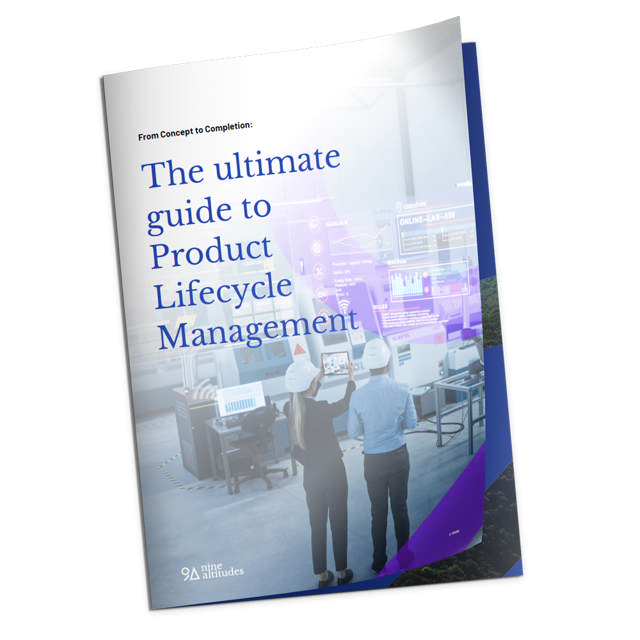
Unlocking seamless product data management: The perfect integration of PLM with other systems
In today's manufacturing landscape, efficient product data management is crucial for success. Companies must streamline their processes to stay ahead, ensuring that every stage of product development and delivery operates smoothly.
This is where Product Lifecycle Management (PLM) comes into play. PLM serves as the backbone of product data management, centralizing information and enhancing collaboration across departments. Integrating PLM with Manufacturing Execution Systems (MES), Configure-Price-Quote (CPQ) systems, and Customer Relationship Management (CRM) systems further amplifies these benefits, creating a seamless, end-to-end solution for managing product data. This article explores how these integrations fill the gaps in your company's processes, driving efficiency and growth.

Yves Vael
Understanding PLM: The backbone of product data management
PLM is designed to manage the entire lifecycle of a product from inception, through engineering design and manufacturing, to service and disposal. PLM centralizes all product-related information, enabling better collaboration among teams and reducing the time it takes to bring a product to market. By providing a single source of truth, PLM ensures that everyone in the organization works with the most up-to-date information, leading to fewer errors and higher quality products. In daily operations, PLM can dramatically improve efficiency by streamlining communication and ensuring that every team member is on the same page.
The Perfect Partnership: PLM and MES
Manufacturing Execution Systems (MES) are critical for managing and monitoring production processes. When integrated with PLM, MES provides real-time data flow from design to production, ensuring that manufacturing teams have access to the latest design specifications and changes. This integration results in improved production efficiency, better quality control, and streamlined processes. For example, if a design change is made in the PLM system, it is automatically reflected in MES, preventing costly errors on the shop floor. This seamless integration enhances overall manufacturing performance and ensures that products are built correctly the first time.

Streamlining production and sales: PLM and CPQ
Configure-Price-Quote (CPQ) systems play a vital role in the sales process by helping sales teams quickly configure products, generate accurate pricing, and produce professional quotes. Integrating CPQ with PLM ensures that the product configurations and pricing information are always accurate and up-to-date. This synergy speeds up the quote generation process, reduces errors, and enhances customer satisfaction. For instance, a manufacturing company that successfully integrated PLM and CPQ reported a significant reduction in quote turnaround time, leading to increased sales and customer trust. By ensuring that sales teams have the most accurate product information, companies can provide better service and close deals faster.
Enhancing customer relations: PLM and CRM
Customer Relationship Management (CRM) systems are essential for managing interactions with current and potential customers. Integrating CRM with PLM provides a comprehensive view of the product lifecycle, from customer feedback and requirements to design improvements and after-sales service. This integration allows companies to offer personalized customer service, make informed sales strategies, and improve product development based on real-world customer data. For example, a company using integrated PLM and CRM can track customer feedback on a new product, quickly relay this information to the design team, and implement improvements, thereby enhancing customer satisfaction and loyalty.
We often see that there is a tendency of looking into ERP or other planning tools to find the source of bad or missing planning, lack of timely materials purchasing, etc. Though many times planning is based on historical data assumptions and not on real life data from CRM, and we therefore see that bad planning often starts in sales and sales forecast, when sales is not used to forecast or isn't working with a CRM system. CRM is therefore often neglected as an important piece of the puzzle.

Next steps and best practices for implementing the integration
Successfully integrating PLM with MES, CPQ, and CRM systems involves several key steps and best practices. Start by conducting a thorough assessment of your current systems and identifying areas for improvement. Choose integration solutions that best meet your company's needs and ensure that all stakeholders are on board. Implement the integration in phases, allowing time for testing and adjustments. Training employees on the new systems is crucial for a smooth transition. Overcoming potential obstacles, such as data migration challenges and resistance to change, requires careful planning and clear communication. By following these steps, your company can achieve a seamless integration that delivers maximum benefits.
Filling the gaps: The comprehensive power of integrated systems
The integration of PLM with MES, CPQ, and CRM systems creates a comprehensive solution that addresses common challenges in product data management. These integrations ensure a seamless workflow, from design and production to sales and customer service. By filling the gaps in traditional product data management approaches, companies can achieve higher efficiency, better quality products, and more satisfied customers. The combined power of these systems results in an interconnected ecosystem where information flows freely, reducing silos and enhancing overall business performance.
By leveraging the combined power of these systems, companies can streamline their processes, reduce time-to-market, and stay competitive in the market. Investing in these integrations is not just a technological upgrade; it's a strategic move towards long-term business success.

E-book: from concept to completion: the ultimate guide to Product Lifecycle Management
In a modern manufacturing environment, PLM has emerged to become a vital piece of the puzzle in a successful, digital landscape. With this e-book, you get the insights you need to achieve long-term success with PLM through a practical approach, that explain the bases of what is PLM, what challenges you can solve, capabilities, and how you get your board to approve an investment in PLM.
Get topics such as "What is PLM, and how can it help my company?", "BoM challenges you can solve with PLM", "How do you get your board to approve PLM," "9 steps to get started" and much more.

Should we have a talk?
Do you have questions about some of the above solutions? Or are you interested in hearing more about how the digital thread creates value for your company? Don't hesitate to fill out the contact form, and one of our experts will return to you with non-binding advice adapted to your situation.

